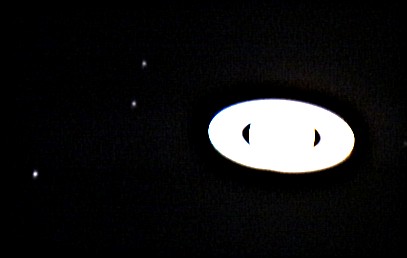

Some of the best images of Saturn are shown here. They all used the the Philips ToUcam with a single 2.5x Barlow, and show nearly diffraction-limited images taken during good seeing in San Diego. The effective focal ratio is now F/16 (3.93 m EFL), with each pixel subtending 0.3 arcsec. This is not quite optimum, but adding the 2x Barlow made the image scale too large for Saturn, requiring very high camera gains and resulting in inferior images. At F/16, the field around Saturn is visible, and the four brightest moons are visible, even without saturating the planet. Normally, 1000 frames at 10 frames per second (a 100 second series) were captured, and the best 10% of these frames were combined after automatically being selected by K3CCD tools. The final image was doubled in size, then a slight amount of unsharp masking was applied. The images below were left as doubled, so don't appear quite as sharp.
Saturn, March 6, 2004
Image taken at 8:13 pm PST. Taken at 10 frames per second with a "1/25" sec setting (actual exposure 100 msec) and camera gain set at 25%. Click on the image to see the first 50 frames of the avi.
The seeing was not very good, even though the planet was directly overhead. A light desert breeze blew away the clouds, but created high altitude turbulence (seen by examining stars). On this night, I was able to image Venus, Mars, Jupiter, and Saturn. The image is not great, but the change in the position of the shadow on the rings is evident. Image tests with 5x Barlows were not nearly as good..
Saturn's moons, March 6, 2004

Image taken at 8:21 pm PST. Taken at 10 frames per second with a "1/25" sec setting (actual exposure 100 msec) and camera gain set at 60%.
I wanted to see if the moons would be visible in a properly-exposed image, but they were too dim. At about 2.5 times the nominal exposure, the planet is overexposed, but three of the moons showed up surprisingly well. From lower left to upper right, they are Rhea (mag 9.5), Tethys (mag 10.0) and Dione (mag 10.2). On nights of better seeing, they might show up without saturating Saturn..
Saturn, December 13, 2003
Image taken at 10:47 pm PST. Taken at 10 frames per second with a "1/25" sec setting (actual exposure 100 msec) and camera gain set at 25%. Click on the image to see the first 50 frames of the avi.
This is the best image from the first use of the webcam on Saturn. Most of the evening was spent trying out different gain and exposure settings. The seeing was slightly below average (about 4/10), but was good enough for these test images.
Left image: F/15, 100 msec exposure, Gain 35%, best 10% of 2000 images. Right image: F/33, 100 msec exposure, Gain 75%, best 10% of 2000 images.
These two images were taken in good seeing; click on each image to see the first 50 frames of each series (note the avi compression caused some saturated frames in the right image, which were not present in the raw data series.) The left image was kept at 2x scaled for better comparison with the right hand image. Note that since the Philips ToUcam seems to clip low light levels at low gains (in the two cameras I have tested), the Cassini division is not properly captured. On the other planets, clipping the low light levels simply affects the terminator, where there is no detail anyway. For Saturn, clipping the low levels makes the gap appear much wider. At the higher gain required for the longer focal length, the background noise level shows up and the true image is seen. The overall image is a little noisier because of the high gain, but I prefer it since it is more realistic. For the rings, this magnification is required. For the planet globe, where bands and storms might appear, the lower focal length is better.
All text and images are owned by Stellar Products, 1992-2004. Any use by others without permission of Stellar Products is prohibited.
Links to other Stellar Products pages:
Stellar Products Image Gallery